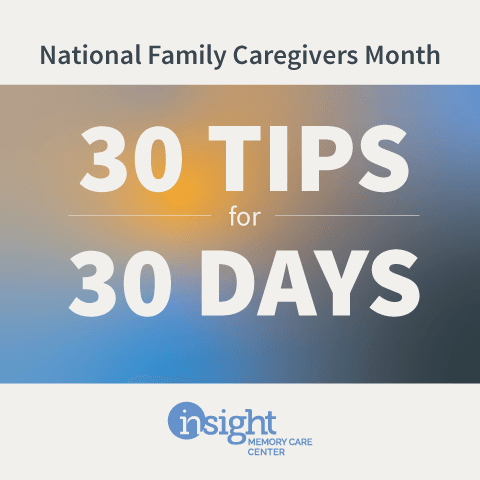
Top 30 Caregiving Tips
The opportunity to become a caregiver for a loved one can be a blessing and bring you closer. However, it can also be overwhelming! You have to deal with everything from how to switch a reversed sleep schedule to finding meaningful activities to fill the day. In honor of National Family Caregivers Month, here are 30 top tips from our Caregiving at a Glance Guide - one for each day of November!
- Join a support group. There are many other people experiencing similar feelings of loss, guilt and frustration who will benefit from hearing from you, and you can learn much from them.
- Take breaks (respite) from caregiving right from the start. Learn to recognize your symptoms of stress and take the time to relieve them.
- Let other people help you. Assume the offers are sincere and allow others to help. They will stop offering when they get tired of it.
- Plan ahead. Look at adult day centers, nursing homes or other places in case you become ill and have to temporarily give up your caregiving responsibilities. Have an alternate plan.
- Read and learn all you can about dementia and Alzheimer’s. Share this information with others who are concerned about your family member. This will help you understand the problems you are encountering as well as alert you to future developments which probably will occur.
- Take care of yourself. Remember, you cannot be an effective caregiver if you fail to stay healthy. Get enough rest, eat right and exercise regularly to keep your energy up.
- Establish a daytime routine for your loved one that does not include a lot of naps. If the person has already reversed the day/night schedule, it may take some concentrated effort and some outside help to reverse the sleep/wake cycle, but it can be done. Adult day care centers often provide the necessary stimuli to keep the person awake.
- Relax a little. If the person gets up, changes back into clothes at midnight and then falls asleep on the bed or in a chair, let it be. Do not insist that the person wear pajamas or sleep in bed if sleeping in the chair is comfortable.
- If the person sits with the food in front of him without eating or eats some and then stops, try reminding him that the food is there, or gently tell them to take a bite of something on their plate. If it looks like the food is being played with but eating isn’t being accomplished, they may be losing their ability to use their silverware. Try making greater use of finger foods; almost anything can be wrapped in a piece of bread and made into a sandwich.
- Identify the person’s usual bath time and routine; you’ll probably have more success if you continue this pattern. Don’t announce that it’s “bath time,” just get everything ready and invite the person to the bathroom, be friendly, guiding and directive in approach. Encourage the person to do as much as possible to increase feelings of self-esteem and confidence.
- Gender of the person who is helping may make a difference in the person’s acceptance of help. You may need to call on a niece, son or enlist a “bather” from a home care agency. Utilize beauty/barber shops for hair care (one less task for you and most people with dementia enjoy being “pampered” in this way).
- Use adult words that are familiar to the person; give clear direct messages (Don’t whisper or use baby talk regarding bathing or toileting issues since this can increase embarrassment).
- Try to figure out why the person is soiling him or herself. Can’t find the bathroom? Show them where it is. Can’t find the toilet? Put a bright colored rug on the floor at the toilet so it stands out. Can’t undo clothes? Give help or simplify clothing.
- If incontinence begins all of a sudden, report it to the physician; it could be a sign of a physical problem or a side effect of a medication.
- Dementia-proof your house. Secure cabinets that hold all poisonous liquids and put away tools that may be misused and result in a harmful situation.
- Troubling behaviors? Make sure that the person is not in pain, sitting on something uncomfortable or too long in one position, that clothes and/or shoes are not ill-fitting or that he is not constipated or needing to urinate. Any of these things can make a usually quiet person more vocal or restless.
- When the person is accusing the caregiver of hiding or taking something, try not to react defensively; instead say, “I know you’re worried about your purse (or whatever is missing). I love you, and I’ll help you look for it.”
- In the early stages, more and more research is pointing to the “use-it-and-keep-it-longer” philosophy. Daily routines should include at least one hour of cognitive exercises that help memory, word fluency and problem-solving techniques.
- Try to focus on the person’s remaining skills even if they seem minimal.
- Your attitude will be important in determining how the person views an activity. If you see it as a “time filler,” the person is likely to reject it and see it as useless.
- Exercise is good for the person with Alzheimer’s disease and the caregiver. Walking is a great way to relive stress and work off excess energy. It is also an activity that a person with dementia can continue to do throughout the disease process.
- If a person comes up with an activity he seems to enjoy and it is safe, inexpensive and keeps him occupied, encourage him to continue it even if it seems meaningless to you.
- Adult day center activities with their peers go a long way toward meeting the needs for companionship and a sense of purpose for persons with dementia. Being able to participate in a daily routine and activities on their level can prove useful and comforting.
- Give only one message at a time. Limit choices. If it’s time for lunch, don’t ask the person if he/she is ready to eat; just say, “It’s time to eat.” On the other hand, give the person choices when it’s o.k.: “Would you like coffee or tea?”
- Listen for a response. It may take up to thirty seconds for the person to figure out what you’ve said and come up with the right words in response.
- Try to agree with at least part of what the person is saying. Don’t start every answer with “No, you can’t!” For example, say “Could you please come here” rather than “No, don’t go out the door!” or “You’re right, you are going home, as soon as your wife gets here”, is easier to take than “You have a long time to wait.”
- Change the subject rather than waste energy arguing. It’s impossible to have a rational argument with someone who can’t be rational. Instead, compliment them on their smile or ask for their help, this may derail their argumentative attempts and help you feel like you’re still in charge.
- A simple written note can sometimes help to calm a person who is trying to remember a particular piece of information.
- Inform your neighbors about the possibility of wandering and give them specific instructions about what to do.
- Laugh: some of the situations you find yourself in are downright funny. Consider it a gift and enjoy the humor.
Looking for more tips? These all come from Insight's Caregiving at a Glance Guidebook, a fingertip guide for families caring for a loved one with Alzheimer's. Techniques and strategies to empower caregivers address topics such as: troublesome behaviors, communication, eating, bathing and more.
Blog
"I like that IMCC focuses on dementia-related problems and provides a focal point for families to network and socially interact in coping with dementia. It provides a community that helps us in our struggle."







